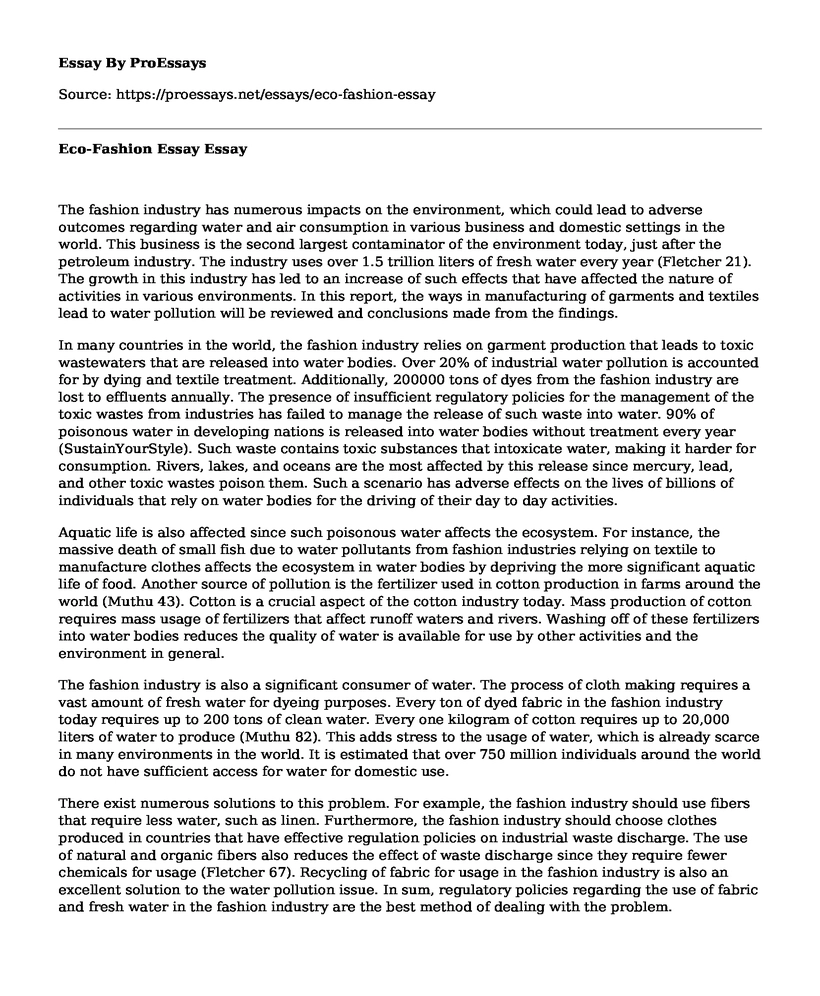The fashion industry has numerous impacts on the environment, which could lead to adverse outcomes regarding water and air consumption in various business and domestic settings in the world. This business is the second largest contaminator of the environment today, just after the petroleum industry. The industry uses over 1.5 trillion liters of fresh water every year (Fletcher 21). The growth in this industry has led to an increase of such effects that have affected the nature of activities in various environments. In this report, the ways in manufacturing of garments and textiles lead to water pollution will be reviewed and conclusions made from the findings.
In many countries in the world, the fashion industry relies on garment production that leads to toxic wastewaters that are released into water bodies. Over 20% of industrial water pollution is accounted for by dying and textile treatment. Additionally, 200000 tons of dyes from the fashion industry are lost to effluents annually. The presence of insufficient regulatory policies for the management of the toxic wastes from industries has failed to manage the release of such waste into water. 90% of poisonous water in developing nations is released into water bodies without treatment every year (SustainYourStyle). Such waste contains toxic substances that intoxicate water, making it harder for consumption. Rivers, lakes, and oceans are the most affected by this release since mercury, lead, and other toxic wastes poison them. Such a scenario has adverse effects on the lives of billions of individuals that rely on water bodies for the driving of their day to day activities.
Aquatic life is also affected since such poisonous water affects the ecosystem. For instance, the massive death of small fish due to water pollutants from fashion industries relying on textile to manufacture clothes affects the ecosystem in water bodies by depriving the more significant aquatic life of food. Another source of pollution is the fertilizer used in cotton production in farms around the world (Muthu 43). Cotton is a crucial aspect of the cotton industry today. Mass production of cotton requires mass usage of fertilizers that affect runoff waters and rivers. Washing off of these fertilizers into water bodies reduces the quality of water is available for use by other activities and the environment in general.
The fashion industry is also a significant consumer of water. The process of cloth making requires a vast amount of fresh water for dyeing purposes. Every ton of dyed fabric in the fashion industry today requires up to 200 tons of clean water. Every one kilogram of cotton requires up to 20,000 liters of water to produce (Muthu 82). This adds stress to the usage of water, which is already scarce in many environments in the world. It is estimated that over 750 million individuals around the world do not have sufficient access for water for domestic use.
There exist numerous solutions to this problem. For example, the fashion industry should use fibers that require less water, such as linen. Furthermore, the fashion industry should choose clothes produced in countries that have effective regulation policies on industrial waste discharge. The use of natural and organic fibers also reduces the effect of waste discharge since they require fewer chemicals for usage (Fletcher 67). Recycling of fabric for usage in the fashion industry is also an excellent solution to the water pollution issue. In sum, regulatory policies regarding the use of fabric and fresh water in the fashion industry are the best method of dealing with the problem.
Works Cited
Fletcher, Kate. Sustainable Fashion and Textiles: Design Journeys. Routledge, 2012.
Muthu, Subramanian S. Sustainability in the Textile Industry. Springer, 2016.
SustainYourStyle. "Environmental Impacts of the Fashion Industry." SustainYourStyle, www.sustainyourstyle.org/old-environmental-impacts. Accessed 28 May 2019.
Cite this page
Eco-Fashion Essay. (2022, Mar 13). Retrieved from https://proessays.net/essays/eco-fashion-essay
If you are the original author of this essay and no longer wish to have it published on the ProEssays website, please click below to request its removal:
- Paper Example on Minors and Social Networks
- Essay Sample on Learning About Death Through Television
- After Watching Genocide Organ Essay Example
- The Significance of the Completion of the Baptistery Doors of the Cathedral of Florence
- Film Analysis Essay on Us: A Chilling Tale of Clones Threatening a Family
- Classmates React to Images of Different Cultures: Impact on Graphic Design - Essay Sample
- Free Paper Sample on Even the Rain (2010) - Netflix film







